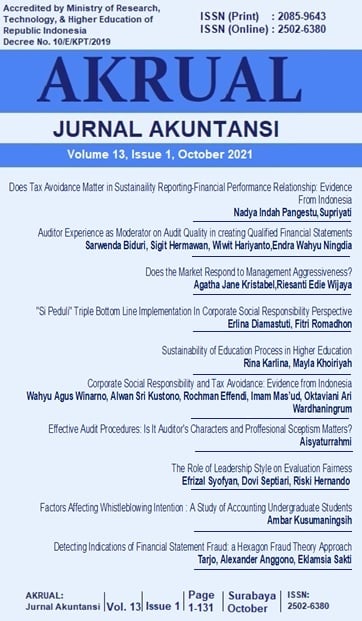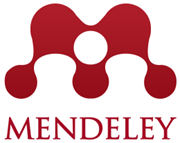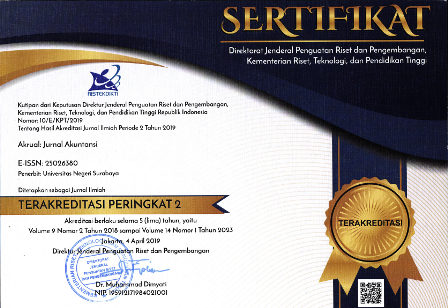The Role of Leadership Style on Evaluation Fairness
DOI:
https://doi.org/10.26740/jaj.v13n1.p94-108Keywords:
Evaluation Fairness, Leadership Style, Financial Performance measure, Non-Financial Performance Measure, Level of ControlAbstract
This study examines the effect of consideration of leadership style on evaluation fairness mediated by a combination of financial and non-financial performance measurements and levers of control. This study takes a population of employees who work at companies in the service, trade, and manufacturing sectors. The research location was conducted in the satellite area of Jakarta (Jabodetabek). We used a questionnaire distributed to respondents using the hand delivery systems technique. The data were analyzed and processed using structural equation modeling - partial least square (SEM-PLS) with the Warp-PLS software 3.0. This study shows that managers who use a consideration of leadership style directly affect the fairness of evaluation within the company. This study also shows that this relationship can be mediated by a combination of financial, non-financial performance measures and levers of control. Although, on a partial mediation basis. This research focuses on the relationship between the influence of leadership style consideration on evaluation justice. This study also looks at the role of mediation by a combination of financial, non-financial performance measurement and levers of control, namely: objective diagnostic, interactive objective, subjective diagnostic, and interactive subjective.
References
Hair, J. F., Black, W. C., Babin, B. J., & Anderson, R. E. (2010). Multivariate data analysis. In Pearson custom library. https://doi.org/10.1038/259433b0
Kori, B., Muathe, S., & Maina, S. (2020). Financial and Non-Financial Measures inEvaluating Performance: The Role of Strategic Intelligence in the Context of Commercial Banks in Kenya. International Business Research, 13, 130. https://doi.org/10.5539/ibr.v13n10p130
Downloads
Published
How to Cite
Issue
Section
License
Copyright (c) 2021 AKRUAL: Jurnal Akuntansi

This work is licensed under a Creative Commons Attribution-NonCommercial 4.0 International License.
 Abstract views: 705
,
Abstract views: 705
, PDF Downloads: 577
PDF Downloads: 577


















